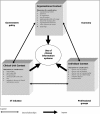Contextual implementation model: a framework for assisting clinical information system implementations
- PMID: 18096917
- PMCID: PMC2274802
- DOI: 10.1197/jamia.M2468
Contextual implementation model: a framework for assisting clinical information system implementations
Abstract
Objective: This paper presents a multiple perspectives model of clinical information system implementation, the CONTEXTual Implementation Model (CIM). Although other implementation models have been developed, few are grounded in data and others fail to take adequate account of the clinical environment and users' requirements.
Design: The CIM arose from qualitative data collected from four clinical units in two large Australian teaching hospitals. The aim of the study was to explore physicians' test management work practices associated with the compulsory use of a hospital-wide, mandatory computerized provider order entry (CPOE) system.(1) The dataset consisted of non-participatory observations of physicians using CPOE (n=55 sessions) and interviews with health professionals (n=28) about test management work practices. Data were analyzed by two researchers independently using an iterative grounded approach.
Results: A core underlying theme of 'contextual differences' emerged which explained physicians' use of the CPOE system in the sites. The CIM focuses attention on diversity at three contextual levels: the organizational level; the clinical or departmental level, and the individual level. Within each of these levels there are dimensions for consideration (for example, organizational culture, leadership and diverse ways of working) which affect physicians' attitudes to, and use of, CPOE.
Conclusion: The CIM provides a contextual differences perspective which can be used to facilitate the implementation of clinical information systems. Developing a clinical information system implementation model serves as a framework to guide future implementations to ensure their safe and efficient use and also improve the likelihood of uptake by physicians.
Figures
Comment in
-
Standing in the shadows of theory.J Am Med Inform Assoc. 2008 Mar-Apr;15(2):263-4. doi: 10.1197/jamia.m2691. J Am Med Inform Assoc. 2008. PMID: 18396512 Free PMC article. No abstract available.
References
-
- In: Kohn LT, Corrigan JM, Donaldson MS, editors. To err is human, building a safer health system. Washington DC: National Academy Press; 2000. - PubMed
-
- Institute of Medicine Committee on Quality of Health Care in America Crossing the quality chasm: a new health system for the 21st centuryWashington DC: National Academies Press; 2001.
-
- Garg AX, Adhikari NKJ, McDonald H, Rosas-Arellano MP, Devereaux PJ, Beyene J, Sam J, Haynes RB. Effects of computerized clinical decision support systems on practitioner performance and patient outcomes: a systematic review JAMA 2005;293:1223-1238. - PubMed
MeSH terms
LinkOut - more resources
Full Text Sources


